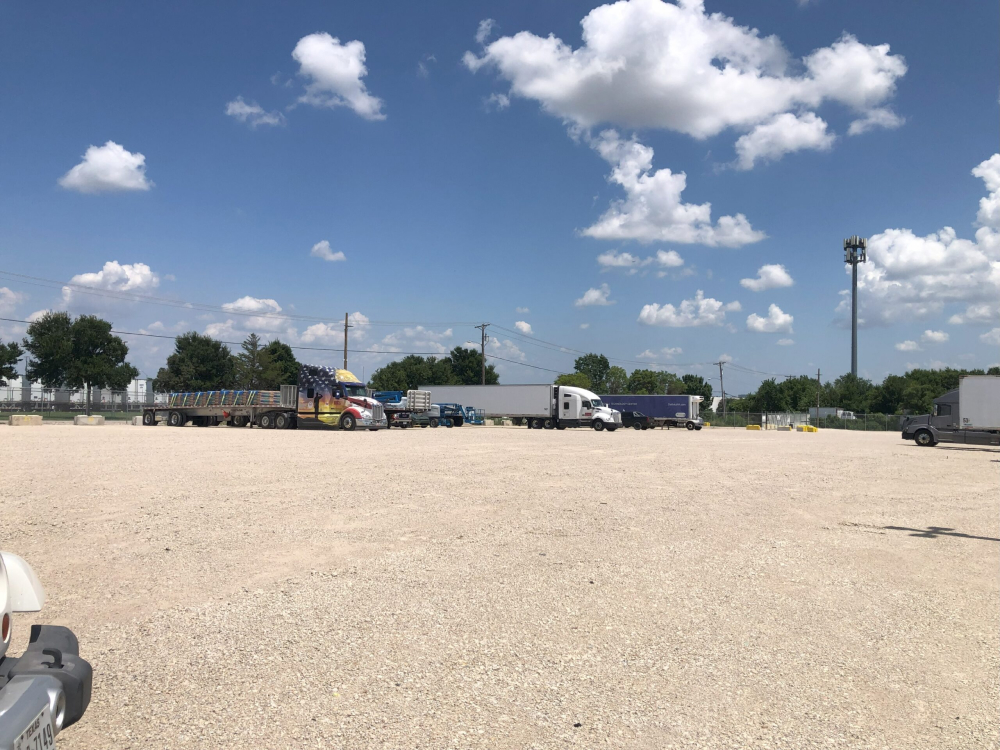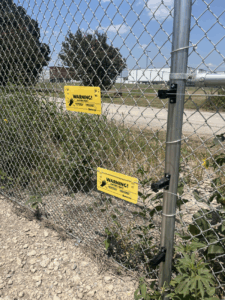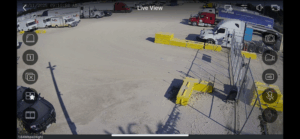Truck drivers across America face a big daily challenge, finding a good spot to park. As our roads get busier, the hunt for parking spaces is not just about convenience, it’s about keeping deliveries running on time and making sure drivers aren’t worn out from the search. This problem affects everyone from the drivers to the businesses relying on timely deliveries.
So, what’s the solution? Building more truck parking lots is a start. But it’s not as simple as just laying down some pavement. There are rules to follow and designs to plan so that these lots truly help drivers. In this blog, we’re going to show you how to design a truck parking lot that makes the best use of every square foot. Whether you’re thinking of turning an unused piece of land into a profitable parking space or just curious about how it’s all done, stick with us. We’ll guide you through everything from choosing the right dimensions to meeting all the necessary regulations.
Why Truck & Trailer Parking is Important
Finding adequate parking is a significant challenge for truck drivers, directly impacting the trucking industry’s efficiency and economic viability. Research by the American Transportation Research Institute reveals that truck drivers spend an average of 56 minutes daily searching for parking. This leads to frustration and results in a considerable economic impact, costing drivers approximately $4,600 annually in lost compensation.
The scarcity of truck parking is more than a convenience issue; it’s a critical safety and compliance concern that can drive drivers out of the industry, exacerbating the existing driver shortage. Providing ample and accessible parking for trucks not only supports the well-being of drivers but also enhances the operational efficiency of the entire supply chain.
Related: Truck Parking vs. Truck Stop Finder App
Why Different Trucks Might Need Different Parking Space Dimensions
In truck parking lot design, it’s essential to recognize that one size does not fit all. Different trucks, from semi-trailers and flatbeds to tankers and delivery vehicles—vary significantly in dimensions, necessitating tailored parking space sizes. For example, while a standard semi-trailer might require a space that’s at least 70 feet long and 12 feet wide, a smaller box truck can be accommodated in a shorter and narrower spot. This customization ensures that drivers can maneuver their vehicles into and out of spaces safely, without the risk of damage or accidents, which is crucial for both safety and operational efficiency.
Additionally, compliance with regional regulations regarding truck parking dimensions is crucial to avoid legal issues and fines. Properly sized spaces also maximize the use of valuable real estate. Overly large spaces waste space, while too small ones can lead to congestion and accessibility problems. Furthermore, the design must consider enough room around parked trucks for safe pedestrian movement and emergency access, enhancing the overall functionality and safety of the parking facility. By tailoring parking lot designs to accommodate different types of trucks, operators can optimize capacity and functionality, making the lot more efficient and user-friendly.
Why Efficient Truck Parking Lot Designs Are Critical for Safety and Profitability
When we think about truck parking lots, it might seem simple—just create spaces where trucks can park, right? But there’s a lot more to it, especially when you consider how these designs impact safety and the bottom line for businesses.
First, let’s talk about safety. A well-designed truck parking lot isn’t just a convenience; it’s a necessity. Trucks are big and heavy, and when they’re coming and going, you want to make sure there’s enough room for them to maneuver without bumping into each other or anything else. Properly sized parking spots and clear driving lanes prevent accidents, which means fewer delays and less money spent on repairs. This keeps drivers safe and goods flowing smoothly to where they need to go.
Now, onto profitability. If a parking lot uses space efficiently, you can fit more trucks into the same area. This is great for businesses because it means they can handle more trucks at any given time, leading to better service and more revenue. Plus, when trucks can easily park and get back on the road, it cuts down on the time they spend idling, which saves fuel and reduces wear and tear on the vehicles.
In short, when truck parking lots are designed smartly, they make everything safer and more efficient. This is why spending time and resources on getting the layout just right is not just good practice—it’s essential. Whether you’re a small lot owner or a big logistics company, investing in a good design upfront pays off in the long run, keeping both drivers and your balance sheet in good shape.
Related: Why Semi Truck Parking in Dallas is a Challenge and How to Solve It
Key Factors in Designing Truck Parking Spaces
There are several key factors you should consider to make sure it’s both safe and efficient. Here’s a look at what matters most:
- Size of Parking Spaces: The size of each parking spot is crucial. It needs to be big enough to fit different types of trucks comfortably. This means considering the length, width, and height of various trucks, from delivery vans to big rigs. Each type of truck has its own space requirement, and getting this right helps prevent accidents and makes it easier for drivers to park and leave.
- Maneuvering Room: Besides just parking, trucks need enough room to move in and out of their spaces. This includes making sure the lanes between parked trucks are wide enough for easy driving without any risk of bumping into other trucks or obstacles. Good maneuvering space is key to a smooth operation and keeps traffic flowing in the parking area.
- Accessibility: Good truck parking design also means thinking about how everyone can use the space easily. This includes clear signs that direct traffic efficiently and accessible features for all drivers, including those with disabilities.
- Safety Features: Safety is a big deal in truck parking lots. Proper lighting, secure barriers, and surveillance cameras can help keep both the trucks and their drivers safe. Also, having emergency information posted and easily accessible emergency exits can make a big difference in safety.
- Environmental Considerations: Finally, a well-designed truck parking lot also considers the environment. This could mean using materials that allow water to drain well, which prevents flooding and reduces pollution. Plus, adding some green spaces or trees can make the lot more pleasant and help manage pollution and heat.
Standard Truck Parking Dimensions & Layout

Truck parking spaces typically need to be around 12 feet wide, with lengths varying from 55 to 75 feet to accommodate most medium to large trucks. For instance, standard semi-trailers require about 55 x 14 feet for effective storage, while truck and trailer combinations need larger spaces, approximately 75 x 14 feet. These dimensions help ensure that trucks have ample room to park without the risk of damage and allow drivers to maneuver comfortably within the lot.
Additionally, maneuvering space is crucial. Drivers generally need about 100 feet to safely back into space, necessitating a clear central area for ease of movement. The required outer turning radius for a medium-sized semi-truck making a 180-degree turn should be at least 40 feet, although 60 feet is recommended for safer and more fluid navigation.
Vertical clearance is another critical aspect, especially for covered parking areas, where a minimum clearance of 14 feet is necessary. This height accommodates taller vehicles, such as trucks with containers or those carrying oversized loads, ensuring they can enter and exit the lot without any hindrance.
Furthermore, parking lot designs should also consider the needs of drivers who may need to leave their cars while on the road. Providing adequate and secure spaces for personal vehicles is essential. For facilities that include loading docks, dimensions should ideally include a width of 10 feet and a height of 4 feet, with the dock area being twice the area of the truck bed to facilitate efficient loading and unloading operations.
Related: Why Semi Truck Parking in Dallas is a Challenge and How to Solve It
How to Measure and Plan for Different Parking Spot Dimensions
First, understand the types of trucks that will use your lot. Different trucks have different sizes and needs. For example, a standard delivery truck is much shorter than a long-haul semi-truck. Knowing what types of vehicles will frequent your lot helps you plan the right mix of parking spot sizes.
Next, measure the length, width, and height of the trucks. For standard truck spots, aim for about 12 feet in width and 55 to 75 feet in length. This size should accommodate most trucks comfortably. For height, if your parking area is covered, ensure a minimum clearance of 14 feet to allow taller trucks to enter and exit without issues.
Now, plan the layout. Space the parking spots so there’s enough room for trucks to maneuver. This means wider aisles and clear markings to guide drivers. Aisles should be at least 25 feet wide to allow easy movement, even for larger vehicles.
Don’t forget to include space for amenities like walkways and rest areas, making sure these are safely positioned and marked. Safety barriers or wheel stops can also help prevent accidents and keep both vehicles and pedestrians safe.
Finally, check local regulations to ensure your parking lot meets all legal requirements for safety and accessibility. This might include specific dimensions for handicap-accessible spots or environmental guidelines for drainage and pavement type.
Related: What Truck Drivers Look for in Truck Parking Facilities
How to Arrange Parking Spots to Make the Most of the Available Area
Arranging parking spots efficiently in a truck parking lot is like playing a smart game of Tetris. You want to fit as many trucks as possible into the lot without wasting space or making it hard for trucks to move around. Here’s how you can plan your parking lot layout to maximize space and functionality.
- Know Your Trucks: Before you draw up any plans, know the types of trucks that will use your lot. Measure the average dimensions of these trucks—length, width, and even their turning radius. This information helps you decide how big each parking spot should be and how much room you need between rows.
- Choose the Right Layout: There are a few common layouts for truck parking lots—straight, angled, and perpendicular. Straight parking is simple and maximizes the number of trucks you can fit. Angled parking makes driving in and out easier, which speeds up movement and can reduce the risk of accidents. Perpendicular parking, though it takes up more space, is easier for drivers to park especially for larger trucks.
- Use Space Smartly: Every bit of space counts. Make sure to design wide enough aisles between parking spots so trucks can move in and out easily without any hassle. Typically, aisles should be at least 25 feet wide for comfortable maneuvering.
- Safety and Accessibility: Ensure your layout includes space for pedestrian movement and emergency access. Also, think about the placement of safety features like lighting, signage, and barriers to keep both the vehicles and people in the parking lot safe.
- Regular Updates: As your truck park gets busier, keep an eye on how the space is used. You might find you need to adjust your layout to handle more trucks or different types of vehicles.
Common Mistakes in Truck Parking Lot Design and How to Avoid Them
A lot can go wrong if not thought out well. Here are some common slip-ups and how to steer clear of them:
- Always design spaces for different truck dimensions to prevent blockages and ensure easy parking for all types of trucks.
- If trucks struggle to navigate in and out, you’ll see bottlenecks. Make sure your layout has wide enough aisles and clear signage to manage smooth flow.
- Skipping on safety, like not enough lighting or missing barriers—can lead to accidents. Good lighting, clear markings, and physical barriers help keep everyone safe.
- Weather can wreak havoc on a poorly prepared lot. Ensure proper drainage to avoid puddles and ice, which are hazards for heavy vehicles.
- Each area has its own rules for truck parks. Make sure you’re up to date with local regulations to avoid fines and redesigns.
Leverage Your Vacant Property: Partnering with Dallas Truck Parking
Do you have unused land? Consider transforming it into a truck parking lot by partnering with Dallas Truck Parking. This move can turn your vacant property into a profitable and busy hub. Truck drivers constantly need safe parking spaces, and by providing a well-designed lot, you solve a significant problem while generating a steady income.
Dallas Truck Parking brings expertise in lot design and management, maximizing your land’s potential. With a strategic layout that includes sufficient parking space dimensions and accessible entries, your lot will attract more drivers, increasing its usage and profitability. Don’t let your property sit idle—explore how this partnership can turn it into a lucrative investment.
Source: https://www.ttnews.com/articles/truck-parking-shortage-costs-drivers-4600-year-expert-says






